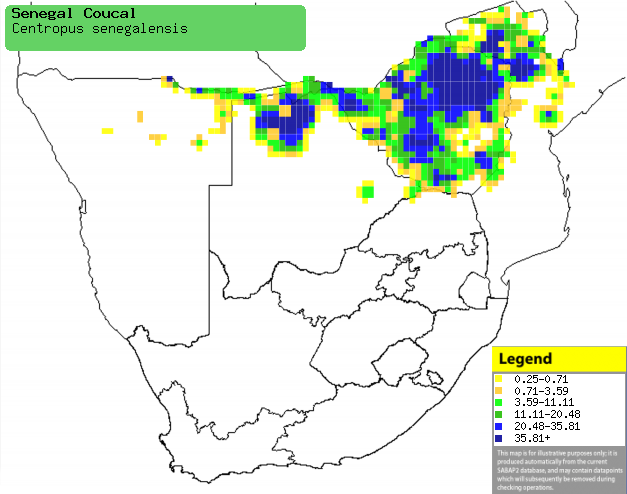|
Centropus senegalensis (Senegal
coucal)
Senegalvleiloerie [Afrikaans]; Mukuku (generic term for
cuckoos and coucals) [Kwangali]; Murenda [Shona]; Senegalese spoorkoekoek
[Dutch]; Coucal du Sénégal [French]; Senegal-spornkuckuck [German]; Cucal do
Senegal [Portuguese]
Life
> Eukaryotes >
Opisthokonta
> Metazoa (animals) >
Bilateria >
Deuterostomia > Chordata >
Craniata > Vertebrata (vertebrates) > Gnathostomata (jawed
vertebrates) > Teleostomi (teleost fish) > Osteichthyes (bony fish) > Class:
Sarcopterygii (lobe-finned
fish) > Stegocephalia (terrestrial
vertebrates) > Tetrapoda
(four-legged vertebrates) > Reptiliomorpha > Amniota >
Reptilia (reptiles) >
Romeriida > Diapsida > Archosauromorpha > Archosauria >
Dinosauria
(dinosaurs) > Saurischia > Theropoda (bipedal predatory dinosaurs) >
Coelurosauria > Maniraptora >Aves
(birds) > Order: Cuculiformes
> Family: Centropidae
Distribution and habitat
It has three separate populations in Africa; one in Egypt,
another in the area from Senegal to Ethiopia south to northern DRC, and finally
one in Tanzania, Zambia, south-eastern Angola and southern Africa.
Within southern Africa it is generally uncommon in north-eastern Namibia,
northern and eastern Botswana, Zimbabwe and central Mozambique. It generally
prefers scrub and thickets along or near watercourses, secondary forest regrowth,
the border between woodland and grassland as all man-modified habitats with
dense cover, such as fallow lands, sugar cane fields, parks and gardens.
|
 |
|
Distribution of Senegal coucal in southern Africa,
based on statistical smoothing of the records from first SA Bird Atlas
Project (©
Animal Demography unit, University of
Cape Town; smoothing by Birgit Erni and Francesca Little). Colours range
from dark blue (most common) through to yellow (least common).
See here for the latest distribution
from the SABAP2. |
Movements and migrations
Resident and sedentary.
Food
Mainly eats invertebrates, reptiles and bird chicks, doing
most of its foraging by searching the vegetation and occasionally descending to the
ground. The following food items have been recorded
in its diet:
- Invertebrates
- Vertebrates
- reptiles
- bird chicks and eggs
Breeding
- Probably monogamous and territorial.
- The nest is likely built solely by the female, consisting of a
loosely-built dome with a side entrance, made of grass and twigs and lined
with green leaves. It is typically placed in a tangled clump of
creepers in a bush or tree.
- Egg-laying season is from October-March, peaking from November-January.
- It lays 2-5 eggs, which are incubated solely by the male for about 17-19
days.
- The chicks are fed by both sexes, leaving the nest after approximately
18-20 days.
Threats
Not threatened, as although thicket clearance has affected
it negatively, it has somewhat benefited from the modification of habitats by
humans.
References
-
Hockey PAR, Dean WRJ and Ryan PG 2005. Roberts
- Birds of southern Africa, VIIth ed. The Trustees of the John Voelcker
Bird Book Fund, Cape Town.
|
